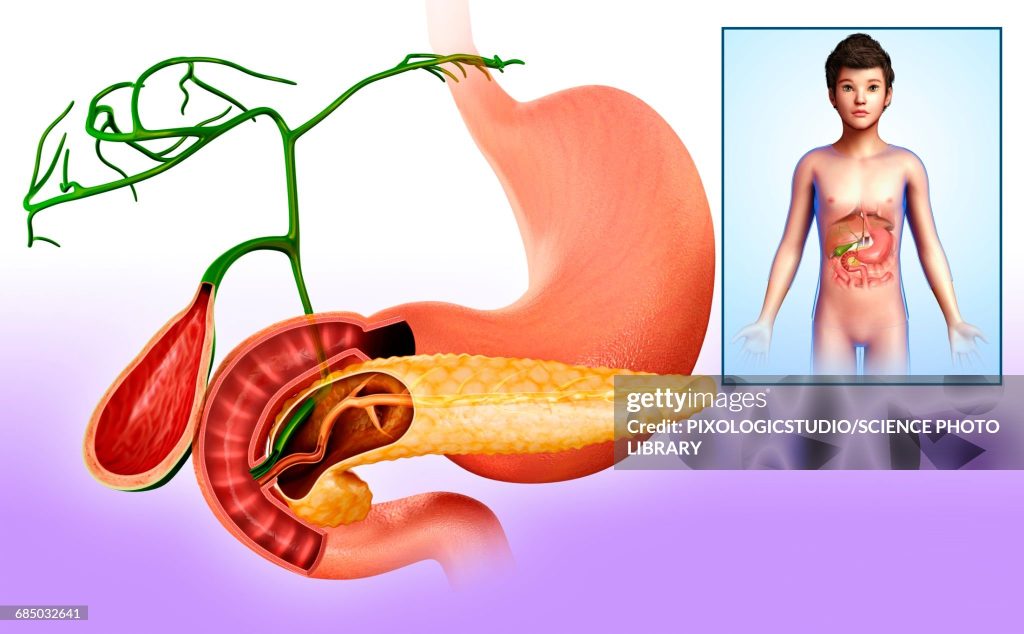
Illustration of pancreas, gallbladder and small intestine anatomy.
Adelekan Oluwaseun Ojo.
Gallstones are hardened deposits of digestive fluid that can form in your gallbladder.
Your gallbladder is a small, pear-shaped organ on the right side of your abdomen, just beneath your liver. The gallbladder holds a digestive fluid called bile that’s released into your small intestine.
Gallstones are hardened deposits of bile that can form in your gallbladder. Bile is a digestive fluid produced in your liver and stored in your gallbladder. When you eat, your gallbladder contracts and empties bile into your small intestine (duodenum).
Gallstones range in size from as small as a grain of sand to as large as a golf ball. Some people develop just one gallstone, while others develop many gallstones at the same time.
People who experience symptoms from their gallstones usually require gallbladder removal surgery. Gallstones that don’t cause any signs and symptoms typically don’t need treatment.
GALLSTONES SYMPTOMS
Gallstones are either cholesterol stones, which are yellow-green, or pigment stones which are smaller and darker. These stones are made of bilirubin. Gallbladder attack symptoms will be acute pain in your upper belly, often towards the right and under your ribs region. Otherwise, it can be acute pain in the right shoulder or your back, stomach upset, vomiting, indigestion, heartburn, or ‘gas.’
Your belly pain can sustain for many hours, with fever and chills, and your skin/eyes can be yellow. Again, gallbladder stone symptoms can be urine, light-colored, sudden pain in the upper right side of your abdomen or center of the abdomen, and backache between the two shoulders and on the right shoulder too.
Gallstones symptoms in female
In females, gallstones may not exhibit any symptoms. If a gallstone gets stuck in a duct, causing a blockage, it can lead to sudden as well as rapidly intensifying pain in the upper right portion of the person’s abdomen or below the breastbone, the center of the abdomen.
Usually, women are more likely to have gallstones than men. Women who possess excess estrogen in their system due to pregnancy, due to hormone replacement therapy, or due to birth control pills may be more likely to have gallstones. Elderly people are more likely to show gallstones.
Gallstone pain normally increases when you take a breath in. Usually, this pain also radiates to the back or under the shoulder blades, behind your breastbone, or on your left side. About one-third of patients will manifest fever and chills. Nausea and vomiting also can appear in such cases.
When the gallstones pass through the small bile duct to the small intestine, there can be inflammation and severe pain, lasting from a few minutes to a few hours. This is very much similar to the pains due to indigestion or an unpleasant feeling of fullness. Additional symptoms are usually severe abdominal pain without any relief from normal pain killers.
Particularly throughout the reproductive years, women are more susceptible to this illness. This is attributed to the estrogen presence, which increases biliary cholesterol secretion.
Gallbladder stones in Men
In men, gallstones may not give out signs or symptoms. He may feel abrupt and fast-growing pain in the upper right portion of his abdomen, in the center of his abdomen, or below his breastbone if a gallstone becomes stuck in a duct and causes stenosis.
When to see a doctor
Make an appointment with your doctor if you have any signs or symptoms that worry you.
Seek immediate care if you develop signs and symptoms of a serious gallstone complication, such as:
Abdominal pain so intense that you can’t sit still or find a comfortable position
Yellowing of your skin and the whites of your eyes (jaundice)
High fever with chills
CAUSES
It’s not clear what causes gallstones to form. Doctors think gallstones may result when:
Your bile contains too much cholesterol. Normally, your bile contains enough chemicals to dissolve the cholesterol excreted by your liver. But if your liver excretes more cholesterol than your bile can dissolve, the excess cholesterol may form into crystals and eventually into stones.
Your bile contains too much bilirubin. Bilirubin is a chemical that’s produced when your body breaks down red blood cells. Certain conditions cause your liver to make too much bilirubin, including liver cirrhosis, biliary tract infections and certain blood disorders. The excess bilirubin contributes to gallstone formation.
Your gallbladder doesn’t empty correctly. If your gallbladder doesn’t empty completely or often enough, bile may become very concentrated, contributing to the formation of gallstones.
Types of gallstones
Types of gallstones that can form in the gallbladder include:
Cholesterol gallstones. The most common type of gallstone, called a cholesterol gallstone, often appears yellow in color. These gallstones are composed mainly of undissolved cholesterol, but may contain other components.
Pigment gallstones. These dark brown or black stones form when your bile contains too much bilirubin.
Risk factors
Factors that may increase your risk of gallstones include:
Being female
Being age 40 or older
Being overweight or obese
Being sedentary
Being pregnant
Eating a high-fat diet
Eating a high-cholesterol diet
Eating a low-fiber diet
Having a family history of gallstones
Having diabetes
Having certain blood disorders, such as sickle cell anemia or leukemia
Losing weight very quickly
Taking medications that contain estrogen, such as oral contraceptives or hormone therapy drugs
Having liver disease
Complications
Complications of gallstones may include:
Inflammation of the gallbladder. A gallstone that becomes lodged in the neck of the gallbladder can cause inflammation of the gallbladder (cholecystitis). Cholecystitis can cause severe pain and fever.
Blockage of the common bile duct. Gallstones can block the tubes (ducts) through which bile flows from your gallbladder or liver to your small intestine. Severe pain, jaundice and bile duct infection can result.
Blockage of the pancreatic duct. The pancreatic duct is a tube that runs from the pancreas and connects to the common bile duct just before entering the duodenum. Pancreatic juices, which aid in digestion, flow through the pancreatic duct.
A gallstone can cause a blockage in the pancreatic duct, which can lead to inflammation of the pancreas (pancreatitis). Pancreatitis causes intense, constant abdominal pain and usually requires hospitalization.
Gallbladder cancer. People with a history of gallstones have an increased risk of gallbladder cancer. But gallbladder cancer is very rare, so even though the risk of cancer is elevated, the likelihood of gallbladder cancer is still very small.
Prevention
You can reduce your risk of gallstones if you:
Don’t skip meals. Try to stick to your usual mealtimes each day. Skipping meals or fasting can increase the risk of gallstones.
Lose weight slowly. If you need to lose weight, go slow. Rapid weight loss can increase the risk of gallstones. Aim to lose 1 or 2 pounds (about 0.5 to 1 kilogram) a week.
Eat more high-fiber foods. Include more fiber-rich foods in your diet, such as fruits, vegetables and whole grains.
Maintain a healthy weight. Obesity and being overweight increase the risk of gallstones. Work to achieve a healthy weight by reducing the number of calories you eat and increasing the amount of physical activity you get. Once you achieve a healthy weight, work to maintain that weight by continuing your healthy diet and continuing to exercise.
Gallbladder Removal
Gallbladder removal surgery is called a cholecystectomy. Cholecystectomy is most commonly practiced by using a tiny video camera and special surgical tools through four small incisions to see inside of your abdomen and remove the gallbladder comfortably (key-hole surgery). Surgeons call this process a laparoscopic cholecystectomy. In certain cases, a large incision may be used to remove the gallbladder as such, depending on various factors.
Gallbladder removal surgery is major surgery with many a risk and complications, but you can go home the same day. Open surgery demands a stay of 3 to 5 days since your recovery time will be longer. Recovery will take around 3 to 4 weeks, and normal life takes 6 to 8 weeks after general surgery of cholecystectomy. You will feel weaker for a few weeks after the surgery, and your abdomen might be a little swollen. But you will have less pain after laparoscopic surgery, and recovery also will be faster.
Normal life is expected after gallbladder surgery, except for some temporary side effects to adjust the digestion of fatty material in food. You may experience stools or diarrhea, bloating, cramping, and excess gas after food.
Gallbladder Removal Side Effects
Side effects of gallbladder removal can give rise to temporary nausea or vomiting. Yellowing of skin or eyes. There will be no bowel movement or passing of gas for 3-4 days after the surgery. Diarrhea can sustain for a few days too. Later, you will be normal without a gallbladder. Your liver will compensate with sufficient bile instead of stocking in the gallbladder, and the liver can directly secrete the same to the digestive tract.
After the gallbladder surgery, it is better to avoid fatty foods such as greasy or fried foods, spicy foods, refined sugar, caffeine, alcohol, carbonated beverages, etc.
Complications of gallbladder removal are secondary infections, bleeding, bile leakage, Injury to the bile duct, intestine, bowel or blood vessels, deep vein thrombosis, etc.
Gallbladder stones treatment without operation
Gallstones treatment can be made without surgery, too, to a great extent depending on other factors. It can be cleansing the gallbladder by taking apple juice, apple cider vinegar, yoga, castor oil pack, etc. Gallbladder cleanses or flushes are believed to support breaking up the gallstones and emptying the gallbladder. There may not be any reported process or scientific evidence for this. But our body is able to cleanse and flush itself with some adjuvant substances. Sometimes, a combination of olive oil, juice, and herbs (like JIGSIMUR HERBAL) is used consistently for days.
……………Adelekan Oluwaseun Ojo, is a counseling psychologist, and a business & health consultant with Jigsimur Zdex Int’l, a company which is into the production and distribution of Jigsimur herbal health drink, a natural curative and preventive herbal medicine from South Africa.
For personal consultation, you can contact us on 07089225319 or 08035122399





